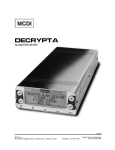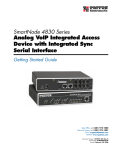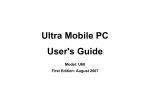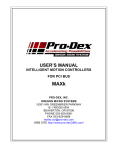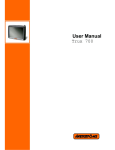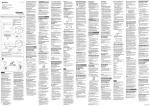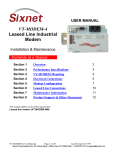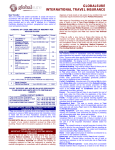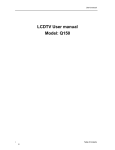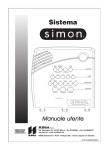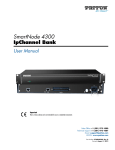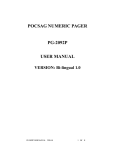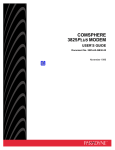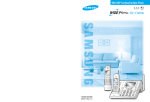Download hp pavilion home pc upgrading and servicing the pc
Transcript
hp pavilion home pc upgrading and servicing the pc The information in this document is subject to change without notice. Hewlett-Packard® Company makes no warranty of any kind with regard to this material, including, but not limited to, the implied warranties of merchantability and fitness for a particular purpose. HP shall not be liable for errors contained herein or for incidental or consequential damages in connection with the furnishing, performance, or use of this material. HP assumes no responsibility for the use or reliability of its software on equipment that is not furnished by HP. This document contains proprietary information that is protected by copyright. All rights are reserved. No part of this document may be photocopied, reproduced, or translated to another language without the prior written consent of HP. Hewlett-Packard Company Home Products Division P.O. Box 4010 Cupertino, CA 95015-4010 USA ©Hewlett-Packard Company, 2000. All rights reserved. Hewlett-Packard is a registered trademark of Hewlett-Packard Company in the United States of America and other countries. Other brand or product names are trademarks of their respective holders. Warning: The HP Pavilion PC may come with software that allows you to copy audio files in the MP3 format. Unauthorized reproduction and distribution of audio MP3 files, or any portion of them, can result in civil and criminal penalties. Features of the HP Pavilion On the top of the chassis is a CD holder (A). Store the CDs that came with the HP Pavilion inside this compartment, so you can quickly locate them if you ever need to reinstall any of the system applications. To connect components to the front of the PC, flip up the port cover (B) and plug the cables into the corresponding connectors. For more information about these ports, see “Connecting External Components” in the User’s Guide. Note: The power supply is pre-set for the country in which you purchased the HP Pavilion. If you move to another location, please make sure you check the voltage requirements in the country you reside before turning on the PC. station de protection contre les décharges électrostatiques, portez un bracelet antistatique relié à une partie métallique de l'ordinateur. Placez les cartes sur un tapis en mousse conducteur ou dans leur emballage, mais ne les posez jamais sur leur emballage. Opening the Computer Warning: The HP Pavilion is heavy; be sure to use ergonomically correct lifting procedures when moving the computer. Warning: Do not operate the system with Avertissement : L’ordinateur HP Pavilion the cover removed. Always replace the cover before turning on the system. est lourd ; suivez des procédures ergonomiques lorsque vous le déplacez. Avertissement : N’utilisez pas le système lorsque son capot est ouvert. Remettez toujours le capot en place avant de mettre le système sous tension. Warning: Electrostatic discharge (ESD) can damage disk drives, add-in cards, and other components. If an ESD station is not available, wear a wrist strap attached to a metal part of the computer. Place cards on a conductive foam pad or inside the conductive wrapper they came in; do not place the cards on top of the wrapper. Avertissement : Des décharges électrostatiques peuvent endommager les unités de disque, cartes d'extension et autres composants. Si vous ne disposez pas d'une Before You Begin Read the following items before attempting to upgrade or service the computer: n These procedures assume familiarity with the general terminology associated with personal computers and with the safety practices and regulatory compliance required for using and modifying electronic equipment. n n n Set up an equipment log to record the system model and serial numbers, all installed options, and other information about the system. If you need this information, it will be easier to consult the log than to open up and examine the system. HP recommends that you use an antistatic wrist strap and a conductive foam pad when working on the system. Disconnect the system from any telecommunications links, networks, or modems, and then disconnect the system power source before performing any of the procedures described in this guide. Failure to do so before you open the system or do any procedures can result in personal injury or equipment damage. Note: Disconnect the modem/phone cable before disconnecting the power cord from the system. To gain access to the inside of the computer, remove the side panel. Removing the Side Panel You must remove the side panel to add memory, insert add-in cards, install or remove drives, or change the battery. 1 Turn off the computer and all peripherals. 2 Disconnect the modem/phone cable. 3 Disconnect the power cord and all other attached cables (such as the keyboard, mouse, and monitor). 4 Loosen the two thumb screws on the right side of the back panel. The first time you loosen these screws you’ll need a flathead screwdriver. (These screws do not detach; they’ll stay on the side panel loosely until you tighten them again.) 5 Stand behind the computer, and place one hand on top of the chassis. 6 Grasp the handle (A) with your other hand and pull the panel towards you until it stops. 7 Lift the panel up and out. Set the panel aside. Removing the Fan Duct To access some components on the motherboard, you may need to remove the fan duct. Note: Make sure the computer is turned off and the modem/phone cable and power cord are disconnected from the computer. 1 Remove the side panel (see “Removing the Side Panel” on page 3). 2 Gently lay the computer on its side. 3 To disengage the fan duct (B), push down on the two tabs (C). You can push with your fingers or a pen. 4 Rotate the fan duct down and out to remove it from the chassis. Removing the Drive Cage The HP Pavilion has two drive cages. The top cage that holds the CD drive(s) is stationary. The bottom cage holds the diskette and hard drive and is removable. You may need to remove this bottom drive cage to access internal components or to add or replace a hard drive. Note: Make sure the computer is turned off and the modem/phone cable and power cord are disconnected from the computer. 1 Remove the side panel (see “Removing the Side Panel” on page 3). 2 Gently lay the computer on its side. 3 Remove the fan duct (see “Removing the Fan Duct” on page 5). 4 Remove the power and IDE cables from the back of the diskette and hard drives. Make note of each connection before disconnecting the cables. 5 Push down on the drive cage release tab (D). 6 Hold the release tab down as you rotate the cage up and lift it out. n 256 MB SDRAM All installed memory modules must be 168pin unbuffered SDRAM (synchronous dynamic random access memory) DIMMs and compliant with the Intel® PC SDRAM Unbuffered DIMM Specification. The HP Pavilion ships with one or more DIMMs, but you can replace the existing DIMM(s) with higher capacity ones. Installing a DIMM Adding Memory The motherboard contains 168-pin DIMM (dual-inline memory module) sockets; the exact number of sockets depends on which model you have. You can install these types of DIMMs in the system: n 64 MB SDRAM n 128 MB SDRAM To install a DIMM: 1 Turn off the computer and all peripherals. 2 Disconnect the modem/phone cable. 3 Disconnect the power cord and all other attached cables (such as the keyboard, mouse, and monitor). 4 Remove the side panel (see “Removing the Side Panel” on page 3). 5 Gently lay the computer on its side. 6 Locate the DIMM sockets on the motherboard. Note: If all of the DIMM sockets are filled, you need to remove one of the DIMMs (see “Removing a DIMM” on page 9). 11 Holding the new DIMM by its edges only, remove it from the antistatic packaging. (Avoid touching the memory chips or the gold contacts on the DIMM.) The DIMM has two small notches on the lower edge that fit into raised bumps in the DIMM socket. 12 Hold the DIMM in alignment with the socket, aligning the notches with the bumps. 7 If necessary to reach the DIMM socket, remove the fan duct (see “Removing the Fan Duct” on page 5). 8 If necessary to reach the DIMM socket, remove the drive cage (see “Removing the Drive Cage” on page 5). 9 Move any cabling out of the way, if necessary. 10 Push down on the two retaining clips on the ends of the DIMM socket. 13 Push straight down on top of the DIMM until it is fully seated in the socket. The retaining clips on the ends of the socket automatically lock it into position when the DIMM is fully seated. 4 Remove the side panel (see “Removing the Side Panel” on page 3). To reassemble the computer: 5 Gently lay the computer on its side. 1 If you moved any cabling, put them back into place. 6 Locate the DIMM sockets on the motherboard. 2 Replace the drive cage, fan duct, and side panel (see “Closing the Computer” on page 20). 7 If necessary to reach the DIMM socket, remove the fan duct (see “Removing the Fan Duct” on page 5). 3 Reconnect the power cord and all other cables. 8 If necessary to reach the DIMM socket, remove the drive cage (see “Removing the Drive Cage” on page 5). 4 Reconnect the modem/phone cable. 5 Turn on the computer and all peripherals. Removing a DIMM 1 Turn off the computer and all peripherals. 2 Disconnect the modem/phone cable. 3 Disconnect the power cord and all other attached cables (such as the keyboard, mouse, and monitor). 9 Move any cabling out of the way, if necessary. 10 Push down on the two retaining clips on the ends of the DIMM socket until the DIMM pops out of the socket. Warning: Do not overload the system by Warning: Do not pull the DIMM out of the socket. Use the retaining clips to eject the DIMM. 11 Holding the DIMM by its edges only, lift it away from the socket. Store it in its antistatic packaging. To install a new DIMM in this socket, see “Installing a DIMM.” Installing Add-In Cards At some point, you may want to add a card to the computer to accommodate a new component, such as a scanner, or to upgrade an existing card. installing add-in cards that draw excessive current. The system is designed to provide 2 amps (average) of +5 V power for each board/card in the computer. The total +5 V current draw in a fully loaded system (one with all add-in card slots filled) must not exceed the total number of slots multiplied by 2 amps. Avertissement : Ne surchargez pas l'ordinateur en installant des cartes d'extension qui consomment beaucoup de courant. L'ordinateur est conçu pour fournir un courant de 2 ampères (en moyenne), +5 volts, à chaque carte installée sur l'ordinateur. La consommation totale de courant de +5 V sur un ordinateur entièrement chargé (dont tous les logements de cartes sont occupés) ne doit pas excéder le nombre total de supports multiplié par 2 ampères. To add or replace an add-in card: 1 Turn off the computer and all peripherals. 2 Disconnect the modem/phone cable. 3 Disconnect the power cord and all other attached cables (such as the keyboard, mouse, and monitor). 4 Remove the side panel (see “Removing the Side Panel” on page 3). 5 Gently lay the computer on its side. 6 To release the add-in card bracket (A), push down on the release mechanism (B) as you pull the bracket. 7 Pull the add-in card bracket up and out. 8 If you’re adding a new card to a previously unused slot, remove the expansion slot cover. Warning: Be careful of the sharp edges on the expansion slot cover. If you’re replacing a card, first disconnect any external and/or internal cables attached to the card. Hold the metal bracket and the far top corner of the card. Carefully remove the card by pulling the card straight out of the expansion slot. 9 Insert the new card into the slot and push straight down. Make sure the card is properly seated. 10 To replace the add-in card bracket, slide the bracket into the hole (C) and then push down until the bracket clicks into place. To reassemble the computer: 1 Replace the side panel (see “Replacing the Side Panel” on page 23). 2 Reconnect the power cord and all other cables. 3 Reconnect the modem/phone cable. 4 Turn on the computer and all peripherals. 5 Install any software drivers supplied by the card manufacturer. What Is Plug and Play? “Plug and Play” describes the ability to add and remove add-in cards, memory, and peripherals without any special procedures (such as resetting jumpers and testing for system conflicts). The system BIOS (basic input/output system) finds these components and adds them to the system. You do not have to run the BIOS Setup program. program and load the default settings, and then save and exit. (See “Using the BIOS Setup Program” in the User’s Guide for more information.) Adding and Removing Drives You can install a second hard drive into the system or replace the existing hard drive. In addition, you can replace the existing diskette or optical drives. Installing a Second Hard Drive The HP Pavilion has an empty 3.5-inch drive bay to accommodate an additional hard drive. If the New Card or Device Isn’t Working 1 Turn off the computer and all peripherals. Read through the card manufacturer’s installation instructions, and recheck all connections, including those to the card, power supply, keyboard, and monitor. If the problem still exists, run the BIOS Setup 3 Disconnect the power cord and all other attached cables (such as the keyboard, mouse, and monitor). 2 Disconnect the modem/phone cable. 4 Remove the side panel (see “Removing the Side Panel” on page 3). 5 Remove the drive cage (see “Removing the Drive Cage” on page 5). Note: Make sure the jumper on the new drive is in the CS (Cable Select) position. 6 Slide the new drive into the empty bay in the drive cage, until the screw holes align. 7 Install the screws on the drive cage. 8 Replace the drive cage (see “Replacing the Drive Cage” on page 20). 9 Attach the power cable to the back of the drive. 10 Attach the connector marked “Master” on the IDE ribbon cable to the back of the primary hard drive. After this primary connection is attached, twist the remaining part of the cable marked “Slave” on that same IDE ribbon cable and connect it to the secondary hard drive. 11 Connect the IDE cable to the motherboard. To reassemble the computer: 1 Replace the side panel (see “Replacing the Side Panel” on page 23). 2 Reconnect the power cord and all other cables. 3 Reconnect the modem/phone cable. 4 Turn on the computer and all peripherals. 5 Install any software drivers supplied by the drive manufacturer. Removing the Preinstalled Hard Drive You need to remove the hard drive from the chassis if you want to replace it with a higher-capacity drive or if you want to safeguard your data when sending the computer out to be repaired. To remove the preinstalled hard drive: 1 Turn off the computer and all peripherals. 2 Disconnect the modem/phone cable. 3 Disconnect the power cord and all other attached cables (such as the keyboard, mouse, and monitor). 4 Remove the side panel (see “Removing the Side Panel” on page 3). 5 Remove the drive cage (see “Removing the Drive Cage” on page 5). 6 Remove the two screws on the side of the hard drive. 7 Pull the hard drive out, and store the drive and screws in a safe location. 8 Replace the drive cage and the side panel (see “Closing the Computer” on page 20). Replacing the Diskette Drive If you need to replace the diskette drive, you can remove the existing drive and install a new one. To ensure that the drive fits properly into the HP Pavilion, be sure to purchase the replacement diskette drive from HP. Refer to your support path card for the telephone number of the HP Customer Care Center. To remove the existing diskette drive: 1 Turn off the computer and all peripherals. 2 Disconnect the modem/phone cable. 3 Disconnect the power cord and all other attached cables (such as the keyboard, mouse, and monitor). 4 Remove the side panel (see “Removing the Side Panel” on page 3). 5 Remove the drive cage (see “Removing the Drive Cage” on page 5). 6 Remove the screw (A) on each side of the diskette drive. 2 Attach the screws on each side of the drive cage. To reassemble the computer: 1 Replace the drive cage (see “Replacing the Drive Cage” on page 20). 2 Reattach the cables to the back of the hard and diskette drives. 3 Replace the side panel (see “Replacing the Side Panel” on page 23). 4 Reconnect the power cord and all other cables. 5 Reconnect the modem/phone cable. 6 Turn on the computer and all peripherals. Note: The second screw (A) is on the other side of the drive cage (not pictured). 7 Pull the diskette drive out. To install a new diskette drive: 1 Slide the diskette drive into the drive cage, until the screw holes align. Replacing an Optical Drive Your computer comes with two optical drives (CD-ROM, DVD, and/or CD-Writer) that you can replace or upgrade. To remove an existing optical drive: 1 Turn off the computer and all peripherals. 2 Disconnect the modem/phone cable. 3 Disconnect the power cord and all other attached cables (such as the keyboard, mouse, and monitor). 4 Remove the side panel (see “Removing the Side Panel” on page 3). 5 Remove the fan duct (see “Removing the Fan Duct” on page 5). 6 Locate the screws (B and C) on the optical drive. 7 If you are removing the bottom optical drive, remove the two screws (C) on the drive and push the drive part way out through the front of the computer. Or If you are removing the top optical drive, remove the screws (B and C) on both optical drives and push both drives part way out through the front of the computer. (This allows better access to the cables at the back of the drive.) 8 Remove the cables on the back of the drive you want to replace. 3 Push the drive(s) all the way in, aligning the screw holes. 4 Attach the screws. To reassemble the computer: 1 Replace the fan duct and side panel (see “Closing the Computer” on page 20). 2 Reconnect the power cord and all other cables. 9 Pull the drive out through the front of the computer. 3 Reconnect the modem/phone cable. To install a new optical drive: 4 Turn on the computer and all peripherals. Note: Make sure the jumper on the new drive is in the 5 Install any software drivers supplied by the drive manufacturer. CS (Cable Select) position. 1 Slide the new optical drive through the front of the computer. Don’t slide the drive in all the way — you need room to attach the cables. 2 Attach the cables to the back of the optical drive. Replacing the Battery A lithium battery on the motherboard provides backup power for the computer’s timekeeping capability. The battery has an estimated life expectancy of seven years. When the battery starts to weaken, the date and time may be incorrect. If the battery fails, replace it with a CR2032 lithium battery (3 volt, 220mAH rating) or an equivalent battery. Warning: There is danger of explosion if the battery is incorrectly replaced. Replace only with the same, or equivalent, type of battery. Discard used batteries according to the manufacturer’s instructions. Avertissement : Le remplacement incorrect de la pile peut provoquer une explosion. Utilisez uniquement une pile de même type ou de type équivalent. Éliminez les piles usées conformément aux instructions du fabricant. To replace the battery: 1 Turn off the computer and all peripherals. 2 Disconnect the modem/phone cable. 3 Disconnect the power cord and all other attached cables (such as the keyboard, mouse, and monitor). 4 Remove the side panel (see “Removing the Side Panel” on page 3). 5 If necessary to reach the battery, remove the drive cage (see “Removing the Drive Cage” on page 5). 6 If necessary to reach the battery, remove the fan duct (see “Removing the Fan Duct” on page 5). 7 If any cards restrict access to the battery: n Remove the add-in card bracket. (See steps 6–7 on page 11.) n Remove the cards that are on or near the battery. 8 With a pen or screwdriver, press the metal latch that holds the battery in its socket. The battery will pop out. 9 Install the new CR2032 battery in the socket, with the positive (+) side facing up. To reassemble the computer: 1 Replace any cards that you removed, and then replace the add-in card bracket. 2 Replace the drive cage, fan duct, and side panel (see “Closing the Computer” on page 20). Replacing the Drive Cage 1 Holding the drive cage at a 45-degree angle, slide the two nubs (A) on the drive cage into the guides (B) on the chassis. 3 Reconnect the power cord and all other cables. 4 Reconnect the modem/phone cable. 5 Turn on the computer and all peripherals. 6 Run the BIOS Setup program to reset the date and time. (See “Using the BIOS Setup Program” in the User’s Guide.) Closing the Computer After you have finished installing memory or drives, inserting or replacing add-in cards, or changing the battery, you need to replace the drive cage, the fan duct, and the side panel. Note: The second nub (A) is on the other side of the drive cage (not pictured). 2 Align the track (C) on the drive cage with the guide (D) on the stationary drive cage. 3 Push the removable drive cage firmly against the stationary cage as you rotate the removable drive down into position. 4 To make sure that the cage is locked into position, grasp the drive cage and pull up forcefully. Note: If you are able to remove the drive cage without pressing the release tab, you didn’t properly align the track with the guide. Repeat steps 1–4 above. Replacing the Fan Duct 1 Holding the fan duct at a 45-degree angle, align the bottom of the duct with the hole on the fan holder. Replacing the Side Panel 1 Lay the panel on top of the chassis, aligning the notches on the panel with the holes on the chassis. 2 Rotate the fan duct into position and make sure it’s securely locked. 2 Slide the panel forward until it locks in place. 3 Tighten the thumb screws on the right side of the back panel. Regulatory and Safety Information Declaration of Conformity According to ISO/IEC Guide 22 and EN 45014 Manufacturer’s Name: Hewlett-Packard Company Manufacturer’s Address: 10500 Ridgeview Ct. Cupertino, CA 95015-4010 USA declares that the product Product HP Pavilion Multimedia Personal Computer Name: System Model 78XXY (X is any number 0-9, Y is any Number(s): alphanumeric character or blank) XT8ZZ (Z is any number 0-9) Product All Options: conforms to the following Product Specifications: Safety: IEC 60950:1991 + A1, A2, A3, A4 EN 60950:1992 + A1, A2, A3, A4, A11 EMC CISPR 22:1993 +A1+A2/ EN 55022:1994 +A1+A2: Class B 1) EN 50082-1:1992 – Generic Immunity IEC 801-2:1991/prEN 55024-2:1992 - 4 kV CD, 8 kV AD IEC 801-3:1984/prEN 55024-3:1991 - 3V/m IEC 801-4:1988/prEN 55024-4:1992 - 0.5 kV Signal Lines, 1 kV Power Lines IEC 61000-3-2:1998/EN61000-3-2:1998 - Harmonics IEC 61000-3-3:1994/EN61000-3-3:1995 - Flicker FCC Title 47 CFR, Part 15 Class B 2)/ICES-003, Issue 2 AS/NZS 3548:1995/CISPR 22:1993 +A1+A2 Class B1) AS/NZS 3548:1995/CISPR 22:1993 +A1+A2 Class B1) Telecom: TBR 21:1998, EG201 121:1998 Supplementary Information: The product herewith complies with the requirements of the following Directives and carries the CE marking accordingly. -the EMC Directive 89/336/EEC (including 93/68/EEC) -the Low Voltage Directive 73/23/EEC (including 93/68/EEC) -the R&TTE Directive 1999/5/EC 1) The Product was tested in a typical configuration with Hewlett-Packard Personal Computer peripherals. 2) This Device complies with Part 15 of the FCC Rules. Operation is subject to the following two conditions: (1) this device may not cause harmful interference, and (2) this device must accept any interference received, including interference that may cause undesired operation. Hardware Quality Engineering Manager Cupertino, CA, USA November, 2000 For Regulatory Compliance Information ONLY, contact: Australian Product Regulations Manager Contact: Hewlett-Packard Australia Ltd. 31-41 Joseph Street Blackburn, Victoria 3130, Australia European Hewlett-Packard GmbH. HQ-TRE Contact: Herrenberger Straße 110-140 D-71034 Böblingen, Germany (FAX: + 49-7031-14-3143) North America Hardware Quality Engineering Manager, Contact: Hewlett-Packard, HPD, 10500 Ridgeview Ct., Cupertino, CA 95015-4010, USA (Phone: 408-343-5000) FCC Regulatory and Safety Information (USA Only) Hewlett-Packard’s system RFI and Radiated Immunity tests were conducted with HP-supported peripheral devices and HP-shielded cables, such as those you receive with your system. Changes or modifications not expressly approved by Hewlett-Packard could void the user’s authority to operate the equipment. To comply with the limits for an FCC Class B computing device, always use shielded signal cables and the power cord supplied with this unit. Federal Communications Commission (FCC) Radio Frequency Interference Statement Warning: This equipment has been tested and found to comply with the limits for a Class B digital device, pursuant to Part 15 of the FCC Rules. These limits are designed to provide reasonable protection against harmful interference in a residential installation. This equipment generates, uses, and can radiate radio frequency energy and, if not installed and used in accordance with the instructions, may cause harmful interference to radio communications. However, there is no guarantee that interference will not occur in a particular installation. If this equipment does cause harmful interference to radio or television reception, which can be determined by turning the equipment off and on, the user is encouraged to correct the interference by one or more of the following measures: n Reorient or relocate the receiving antenna. n Increase the separation between the equipment and the receiver. Connect the equipment into an outlet that is on a circuit different from the receiver. Consult the dealer or an experienced radio/TV technician for help. n n Consumer Information and FCC Requirements Telephone Connection n n This equipment complies with Part 68 of the Federal Communications Commission rules. These rules permit this device to be directly connected to the telephone network. Standardized jacks are used for these connections. This equipment should not be used on party lines or coin lines. If this device is malfunctioning, it may also cause harm to the telephone network; this device should be disconnected until the source of the problem can be determined and until it has been repaired. If this is not done, the telephone company may temporarily disconnect your service. n n The telephone company may make changes in its technical operations and procedures. If such changes affect the compatibility or use of this device, the telephone company is required to give adequate notice of the changes. If the telephone company requests information on what equipment is connected to their lines, inform them of: a The telephone number this unit is connected to b The ringer equivalence number c The USOC jack required: RJ-11C d The FCC Registration Number Items (b) and (c) are indicated on the label. The ringer equivalence number (REN) is used to determine how many devices can be connected to your telephone line. In most areas, the sum of the RENs on any one line should not exceed five (5.0). If too many devices are attached, they may not ring properly. n In the event of equipment malfunction, HewlettPackard or an authorized HP Personal Computer Dealer Repair Center should perform all repairs. It is the responsibility of users requiring service to report the problem to HP’s Home Products Division, or to one of our authorized agents. Service can be obtained by calling the HP Customer Care Center at 208-323-4663 (United States). Statement of Fax Branding The Consumer Protection Act of 1991 makes it unlawful for any person to use a computer or other electronic device to send any message via telephone fax machine, unless it clearly contains: a margin at the top or bottom of each transmitted page or on the first page of the transmission, the date and time it is sent, identification of the business or other entity, or individual sending the message, the telephone number of the sending machine or such business, entity, or individual. ENERGY STAR Compliance Hewlett-Packard Pavilion PCs and monitors marked with the ENERGY STAR logo comply with the U.S. Environmental Protection Agency’s ENERGY STAR guidelines for energy efficiency. For information on changing power management features, refer to “Putting the Computer into Standby and Hibernation Mode” in the Quick Start Guide. ENERGY STAR is a U.S. registered service mark of the United States Environmental Protection Agency. Canada Department of Communications (DOC) Notice Telephone Connection The Canada Department of Communications label identifies certified equipment. This certification means that the equipment meets certain telecommunications network protective, operational, and safety requirements. The department does not guarantee the equipment will operate to the user’s satisfaction. Before installing this equipment, the user should ensure it is permissible to connect it to the facilities of the local communications company. The equipment must be installed using an acceptable method of connection. In some cases, the company’s inside wiring associated with a single line individual service may be extended by means of a certified connector assembly (telephone extension cord). The customer should be aware that compliance with the above conditions may not prevent degradation of service in some situations. Repairs to certified equipment should be made by an authorized Canadian maintenance facility designated by the supplier. Any repairs or alterations made by the user to this equipment, or equipment malfunctions, may give the telecommunications company cause to request that the user disconnect the equipment. Users should ensure, for their own protection, that the electrical ground connections of the power utility, telephone lines, and internal metallic water pipe systems, if present, are connected together. This precaution may be particularly important in rural areas. Warning: Users should not attempt to make such connections themselves, but should contact the appropriate electrical inspection authority or electrician, as appropriate. Avertissement : L’utilisateur ne devrait pas tenter de faire ces connexions lui-même mais devrait utiliser les services de l’organisme approprié d’inspection des installations électriques ou d’un électricien, selon le cas. Warning: The Load Number .9 assigned to each terminal device denotes the percentage of the total load to be connected to a telephone loop; this is used by the device to prevent overloading. The termination on a loop may consist of any combination of devices, subject only to the requirement that the sum of the Load Numbers does not exceed 100. Avertissement : La valeur de charge .9 attribuée à chaque élément terminal indique le pourcentage de la charge totale pouvant être connecté à une boucle téléphonique. Cette valeur est utilisée pour éviter les surcharges. La terminaison d’une boucle peut être constituée d’une combinaison quelconque d’équipements, dans la mesure où la somme des valeurs de charge ne dépasse pas 100. DOC Statement (Canada Only) This Class B digital apparatus meets all requirements of the Canadian Interference-Causing Equipment Regulations. Cet appareil numerique de la classe B respecte toutes les exigences du Reglement sur le materiel brouilleur du Canada. Austel Statement (Australia Only) When setting the number of automatic redials for the modem, ensure the following: The number of automatic redials that the modem performs should be limited to a maximum of 9 redials plus the original call. If the above retries are unsuccessful, no further attempts should be made to the same number for a minimum period of five minutes. Warning: Failure to set the modem, and any communication software used with the modem, to the values contained in the listing will result in the modem being operated in a non-compliant manner. Consequently, there would be no permit in force for this equipment, and the Telecommunications Act 1991 prescribes a penalty of A$12,000 for the connection of non-permitted equipment. Australia/New Zealand Telecom Statement Your modem has been granted an Austel Permit for use in Australia and a New Zealand Telecom Telepermit for use in New Zealand. In each country, special conditions apply to the settings and features of your modem. Failure to observe these conditions might result in heavy penalties being applied (up to A$12,000.00 in Australia). Warning: For safety reasons, only connect equipment with a telecommunications compliance label. This includes customer equipment previously labeled, permitted or certified. The grant of a Permit/Telepermit in no way indicates the telecom agency’s acceptance of responsibility for the correct operation of that device under all operating conditions. In particular, the higher speeds at which this modem is capable of operating depend on a specific network implementation which is only one of many ways of delivering high-quality voice telephone to customers. Failure to operate should not be reported as a fault to Telecom or Austel. In addition to satisfactory line conditions, a modem can work properly only if: It is compatible with the modem at the other end of the call, and n The application using the modem is compatible with the application at the other end of the call; for example, accessing the Internet requires suitable software in addition to a modem. This equipment shall not be used in any manner which could constitute a nuisance to other customers. n The setting and features discussed below influence how your modem reacts with the telephone network. If changes from the default values are made, then it is possible that unwanted signals or interference may be generated, your modem might dial wrong numbers or suffer from a reduced level of performance. We strongly recommend that the settings are not changed under any circumstances or the Permit/Telepermit may become invalid. Initialization Many communications programs react to the default settings when started. This is usually achieved by the ATZ command and initializes your modem for correct operation. Many programs are developed for worldwide use and generally use the ATZ command; however, some programs have built-in modem configuration utilities and these should not be used unless you can confirm that they are compatible with Australian and New Zealand requirements. If your program does not use the ATZ command to initialize, but instead sends a complex string of characters, then it must be configured to send the correct string for Australia and New Zealand. The correct initialization string is (spaces should not be entered; they are to make it easier to read): AT &F T /N6 S6=3 S7=45 % L=7 &Y0 &W0 Once you have entered this command string, it is written to the internal memory of the modem and the default configuration. Dialing The modem supports both pulse and tone dialing in Australia and only tone dialing in New Zealand. New Zealand users please note that if pulse dialing is selected, then wrong numbers will be dialed, as the reverse numbering scheme is not supported. There are several dial string modifiers referred to in the main users’ manual, and we suggest that they be used with caution to avoid problems when making calls. Automatic Answering To conform with Austel and Telecom New Zealand requirements when configuring your modem for autoanswering, please do not set the SO register to values less than 2 or greater than 10 (Note: ATSO-O will disable auto-answering). Pre-configured software should be checked and changed as necessary. These settings ensure: n A person calling your modem will hear a short burst of ringing before the modem answers. This confirms that the call has been successfully switched through the network. n Caller identification information (which occurs between the first and second ring cadences) is not destroyed. Automatic Multiple Dialing Attempts Most communication software can be configured to make automatic dialing attempts to a telephone number that is busy or not answering (automatic redial function). The maximum number of all attempts that can be made in one sequence must not exceed the numbers shown in the following table. If your program makes continuous automatic dialing attempts or more than the number in the table, and it cannot be changed, an alternative program must be used or automatic dialing disabled. There is no limit for manually initiated dialing attempts. Country Number of Pauses attempts per between sequence attempts (seconds) 10 Australia New Zealand 10 3 60 Pauses between sequences (minutes) 30 60 Bell Compatible Operation Bell compatible mode should not be used. Nearly all modems use CCITT mode because Bell mode is limited to a maximum speed of 300 or 1200 BPS, and some network interference problems may arise due to line signaling requirements. Parallel Telephones If you find that you regularly experience line noise or other interference when using your modem, we suggest disconnecting other telephones from the line. Some telephones may place a load across the telephone line when not in use, which adversely affects the performance of your modem. If disconnecting parallel telephones reduces the interference, then it may be necessary to have the telephone(s) repaired or replaced. Warning: New Zealand users only: Please note that operation of this modem on the same line as telephones or other equipment with audible ringing devices, or automatic ringing detectors, may cause “bell tinkle” or false tripping of the ringing detector. If this occurs, do not contact Telecom Faults Service. Also, please note that the power consumed from the telephone line by this modem may not provide for the effective transfer of a call to or from other equipment connected to the same line. Connecting to Other Equipment There are two telephone line sockets in your modem, marked LINE and PHONE. The telephone line is connected to the LINE socket, and other equipment, such as the telephone, is connected to the PHONE socket. Please note that Austel permitted/NZ Telepermitted equipment only may be connected to the PHONE socket. Miscellaneous There are many commands referred to in the main user’s manual. Incorrect use of some of these commands may render your modem inoperative or severely degrade its performance. Generally, it is best not to change any setting unless you are an experienced user. Should you accidentally alter any settings, and are unsure how to undo the changes, it is best to completely re-initialize your modem by giving the AT&F command (the only time you should use this command) and then manually enter the initialization string of point A. This will reset your modem to the correct settings for Australia and New Zealand. Voice Features If your new modem is fitted with voice features, then it is illegal in Australia and New Zealand to use it with software that allows recording of telephone conversations. (It can be used as an answering machine, mail box center, telemarketing system, and so forth, but it cannot be used to record a “live” conversation between telephone users.) If your software supports telephone conversation recording (perhaps called Two-way Recording), then this feature must be disabled in the program configuration. EMI Statement (European Union Only) This is a class B product. In a domestic environment, this product may cause radio interference in which case the user may be required to take adequate measures. European Telephone Network Declaration (European Union Only) The product herewith complies with the requirements of the R&TTE Directive 1999/5/EC (Annex II) and carries the CE marking accordingly. However, due to differences between the individual PSTNs provided in different countries, the approval does not, of itself, give an unconditional assurance of successful operation on every PSTN network termination point. In the event of problems, you should contact your equipment supplier in the first instance. European Network Compatibility Declarations (European Union Only) This equipment has been designed to work with analogue DTMF Networks (TBR-21 compliant). This equipment may have internetworking difficulties in PSTN networks that only support Pulse Dialing. Please consult with your network operator for further assistance. UK Compliance Information This modem is approved by the Secretary of State at the Department of Trade and Industry for connection to a single exchange line of the public switch telephone network run by certain licensed public telecommunication operators or systems connected thereto. (Direct exchange lines only, not shared service or 1-1 carrier systems.) This modem is also suitable for connection to Private Automatic Branch Exchanges (PABXs) which return secondary proceed indication. If this modem is to be used with a PBX which returns secondary proceed indication, no more than two pauses of four seconds duration each should be inserted between the initial PSTN access digit and the number to be dialed. This is to avoid interference to the PTO network. If this modem is to be used with a PBX which has extension wiring owned by BT, connection of the modem to the PBX can only be carried out by BT; or, by the authorized maintainer of the PNX unless the authorised maintainer has been given 14 days written notice that the connection is to be made by another person, and that period of notice has expired. This modem is suitable for use only on telephone lines provided with Loop-Disconnect or Multi-Frequency Dialling facilities. Users of this modem are advised that the approval is for connection to the PSTN via the telephone line interference supplied with it. Connection of a modem to the PSTN by any other means will invalidate the approval. There is no guarantee of correct working in all circumstances. Any difficulties should be referred to your supplier. Some network operators require that intended users of their network request permission to connect and for the installation of an appropriate socket. Ringer Equivalence Number The ringer equivalence number (REN) of this modem is 1. REN is a guide to the maximum number of apparatuses that can be simultaneously connected to one telephone line. The REN value of each apparatus is added together, and should not exceed 4. Unless otherwise marked, a telephone can be assumed to have a REN value of 1. Approved Usage This modem is approved only for the following: n n n Storage of telephone numbers for retrieval by a predetermined code Detection of initial proceed indication Automatic calling/Automatic answering n Tone detection Operation in the absence as a secondary proceed indication n Loudspeaking facility This modem is NOT suitable for use as an extension to a payphone. n This modem is not approved for connection to UK private speechband services. This modem does not support the automatic redial function. Any other usage will invalidate the approval of your modem, if, as a result, it then ceases to conform to the standards against which approval was granted. The approval of this modem is INVALIDATED if the apparatus is subject to modification in any material way not authorised by the BABT or if it is used with or connected to external software that has not been formally accepted by BABT. Storage of Numbers It is advisable to check the telephone numbers stored in your modem immediately after programming. In order to prevent the misdirection of class and network interference, please ensure that all manually programmed telephone numbers are correctly entered. The number you enter to dial may optionally contain a PAUSE character (a comma) to allow this modem to operate with a PABX. Each comma gives a two-second delay. Additional Safety Information This product has not been evaluated for connection to an “IT” power system (an AC distribution system with no direct connection to earth, according to IEC 60950). AC Power Safety Warning Warning: Install the computer near an AC outlet. The AC power cord is your HP Pavilion PC’s main AC disconnecting device and must be easily accessible at all times. For your safety, the power cord provided with your system has a grounded plug. Always use the power cord with a properly grounded wall outlet, to avoid the risk of electrical shock. Warning: Your system is provided with a voltage select switch for use in a 115 or 230 Vac power system. The voltage select switch has been pre-set to the correct voltage setting for use in the particular country where it was initially sold. Changing the voltage select switch to the incorrect position can damage your PC and void any implied warranty. Warning: To reduce the possibility of an electric shock from the telephone network, plug your computer into the AC outlet before connecting it to the telephone line. Also, disconnect the telephone line before unplugging your computer from the AC power outlet. Warning: Always disconnect the modem cord from the telephone system before installing or removing your computer cover. Warning: Do not operate the computer with the cover removed. Warning: The power supply is not user-serviceable. To prevent damage to the power supply, have a qualified person repair or replace it. All other components are user-serviceable. Warning: Electrostatic discharge (ESD) can damage disk drives, add-in cards, and other components. If an ESD station is not available, wear a wrist strap attached to a metal part of the computer. Place cards on a conductive foam pad or inside the card wrapper, if possible, but never on the card wrapper. Warning: For your safety, always unplug the system from its power source and from any telecommunications systems (such as phone lines), networks, or modems before performing any of the procedures described in this guide. Failure to do so may result in personal injury or equipment damage. Hazardous voltage levels are inside the power supply and modem of this product. Warning: This modem is designed and approved independently of the host PC in which it will be used. The power required by the host PC and all the other adapter cards installed within it, together with any auxiliary apparatus, shall not exceed the total power supply of the host apparatus. The power requirements of this adapter are +5V (1A) and -5V (100Ma). It is essential that when other optional cards are introduced into the host PC, which may use or generate a hazardous voltage, a minimum creepage distance of 5mm and a clearance of 4mm is maintained between any hazardous voltage and this modem card. The maximum voltage used or generated by the host PC is assumed to be up to 250V maximum. If greater voltages are present in the host, the creepages and clearances must be increased accordingly. If you have any doubt, seek advice from a competent engineer before installing other adapters into the host PC. Note: A hazardous voltage is one which exceeds 42.4V peak AC or 60V DC. Clearance is the shortest distance through air. Creepage is the shortest path measured along the surface of insulation. Avertissement : Installez l'ordinateur à proximité d'une prise c.a. Le cordon d'alimentation c.a. est le principal dispositif de déconnexion de l'ordinateur HP Pavilion et doit toujours être facilement accessible. Pour votre sécurité, le cordon d'alimentation fourni avec votre système possède une prise avec mise à la terre. Branchez toujours le cordon dans une prise murale avec mise à la terre, afin d'éviter les risques d'électrocution. Avertissement : Votre système est doté d’un commutateur de sélection de tension (115 ou 230 volts c.a.). Ce commutateur a été placé sur la tension appropriée pour le pays dans lequel l’équipement est initialement vendu. Mettre le commutateur à la mauvaise position peut endommager l’ordinateur et annuler toute garantie implicite. Avertissement : Pour réduire les risques de choc électrique en provenance du réseau téléphonique, branchez votre ordinateur dans une prise c.a. avant de le connecter à une ligne téléphonique. En outre, déconnectez votre ligne téléphonique avant de débrancher votre ordinateur de la prise c.a. Avertissement : Débranchez la carte modem du réseau téléphonique avant d'installer ou d'enlever le couvercle de votre ordinateur. Avertissement : N’utilisez pas l’ordinateur lorsque le capot est enlevé. Avertissement : Le bloc d’alimentation n’est pas réparable par l’utilisateur. Pour éviter d’endommager le bloc d’alimentation, confiez-le à un technicien pour réparation ou remplacement. Tous les autres composants peuvent être changés ou réparés par l’utilisateur. Avertissement : Des décharges électrostatiques peuvent endommager les unités de disque, cartes d’extension et autres composants. Si vous ne disposez pas d’une station de protection contre les décharges électrostatiques, portez un bracelet antistatique relié à une partie métallique de l’ordinateur. Placez les cartes sur un tapis en mousse conducteur ou dans leur emballage, mais ne les posez jamais sur leur emballage. Avertissement : Pour plus de sécurité, débranchez toujours le système de sa source d’alimentation, de tout système de télécommunications (comme les lignes téléphoniques), des réseaux et des modems avant d’exécuter l’une des procédures décrites dans ce chapitre. Si vous ne respectez pas ces consignes, vous risquez de vous blesser et de causer des dommages matériels. Des niveaux de tension dangereux se trouvent à l’intérieur du bloc d’alimentation et du modem de ce produit. Avertissement : Ce modem est conçu et approuvé indépendamment de l'ordinateur hôte avec lequel il est utilisé. L'alimentation électrique nécessaire à l'ordinateur hôte, à toutes les cartes qui y sont installées et à tous les appareils auxiliaires ne doit pas dépasser la puissance totale de l'appareil hôte. Les exigences d'alimentation électrique de cet adaptateur sont de +5 V (1 A) et -5 V (100 Ma). Lorsque d'autres cartes facultatives sont installées dans l'ordinateur hôte (lesquelles peuvent utiliser ou produire des tensions dangereuses), il est essentiel de prévoir une ligne de fuite minimale de 5 mm et un dégagement de 4 mm entre toute tension dangereuse et cette carte modem. La tension maximale utilisée ou produite par le micro-ordinateur hôte est normalement de 250 V. Si des tensions plus élevées sont présentes dans l'ordinateur hôte, les lignes de fuite et les dégagements doivent être ajustés en conséquence. En cas de doute, demandez l'avis d'un technicien compétent avant d'installer d'autres cartes dans l'ordinateur hôte. Remarque : Les tensions dangereuses sont celles qui dépassent 42,4 V c.a. en crête ou 60 V c.c. Le dégagement est la plus petite distance aérienne. La ligne de fuite est la plus petite trajectoire mesurée sur la surface de l'isolation. Avertissement : L’ordinateur utilise une pile au lithium de type CR2032. Le remplacement incorrect de la pile peut provoquer une explosion. Utilisez uniquement une pile de même type ou de type équivalent. Éliminez les piles usées conformément aux instructions du fabricant. Varning! PC:n använder ett litiumbatteri, typ CR2032. Vid felaktigt batteribyte föreligger risk för explosion. Ersätt bara med samma eller liknande batterityp, rekommenderad av tillverkaren. Gör dig av med batterierna enligt tillverkarens instruktioner. Advarsel: PCen bruker et litiumbatteri av typen Lithium Battery Caution Warning: The PC uses a lithium battery, type CR2032. There is danger of an explosion if the battery is incorrectly replaced. Replace only with the same, or equivalent, type recommended by the manufacturer. Dispose of used batteries according to the manufacturer’s instructions. Warnung: In diesem PC wird eine Lithiumbatterie des Typs CR2032 verwendet. Wenn Sie beim Austauschen dieser Batterie nicht sachgemäß vorgehen, besteht Explosionsgefahr. Ersetzen Sie die Batterie nur durch eine Batterie desselben Typs oder eines entsprechenden, vom Hersteller empfohlenen Typs. Befolgen Sie bei der Entsorgung gebrauchter Batterien die Anweisungen des Herstellers. CR2032. Dersom det brukes feil batteri, kan det oppstå fare for eksplosjon. Du må bare bruke batteritypen som anbefales av produsenten, eller tilsvarende batterier. Følg produsentens instruksjoner for kassering av brukte batterier. Varoitus: PC käyttää CR2032-tyyppistä litiumparistoa. Räjähdyksen vaara, jos paristo vaihdetaan väärin. Vaihda vain samanlaiseen tai vastaavaan valmistajan suosittelemaan paristoon. Käytetyt paristot täytyy hävittää valmistajan ohjeiden mukaisesti. Waarschuwing: De PC gebruikt een lithiumbatterij, type CR2032. Er bestaat explosiegevaar als de batterij niet goed wordt vervangen. Vervang de batterij uitsluitend door een batterij van hetzelfde of een gelijkwaardig type, dat wordt aanbevolen door de leverancier. Behandel gebruikte batterijen volgens de aanwijzingen van de leverancier. Laser Safety Statement Class 1 LED Product The CD-ROM and DVD drives contain a laser system and are classified as a “Class 1 Laser Product” under a U.S. Department of Health and Human Services (DHHS) Radiation Performance standard according to the Radiation Control for Health and Safety Act of 1968. Should the unit ever require maintenance, contact an authorized service location. Warning: Use of controls, adjustments, or performance procedures other than those specified in the HP Pavilion PC User’s Guide may result in hazardous radiation exposure. To prevent direct exposure to laser beam, do not try to open the enclosure of the CD-ROM or DVD. Avertissement : L’utilisation de commandes, réglages ou procédures de performance autres que ceux spécifiés dans le Guide de l’utilisateur de l’ordinateur HP Pavilion peut entraîner une exposition à des radiations. Afin d’éviter une exposition directe au rayon laser, ne tentez pas d’ouvrir le boîtier du lecteur de CD-ROM ou DVD. TV Antenna Connectors Protection External Television Antenna Grounding If an outside antenna or cable system is connected to the product, be sure the antenna or cable system is electrically grounded so as to provide some protection against voltage surges and built-up static charges. Article 810 of the National Electrical Code, ANSI/NFPA 70, provides information with regard to proper electrical grounding of the mast and supporting structure, grounding of the lead-in wire to an antennadischarge unit, size of grounding conductors, location of antenna-discharge unit, connection to grounding electrodes, and requirements for the grounding electrode. Lightning Protection For added protection of any Hewlett-Packard product during a lightning storm, or when it is left unattended and unused for long periods of time, unplug the product from the wall outlet and disconnect the antenna or cable system. This will prevent damage to the product from lightning and power line surges. Power Lines Operating Specifications An outside antenna system should not be located in the vicinity of overhead power lines or other electric light or power circuits, or where it can fall into such power lines or circuits. Electrical ratings Models 78XXY/ XT8ZZ — 100–127 V /200–240 V , 4/2 A, 50/60 Hz Operating temperature 5° to 35° C Storage temperature –40° to 70° C Warning: When installing an outside antenna system, extreme care should be taken to keep from touching such power lines or circuits as contact with them could be fatal. Avertissement : Lorsque vous installez une antenne extérieure, vous devez faire attention à ne pas toucher ces lignes et circuits d’alimentation, tout contact pouvant être mortel. Operating humidity 15 to 80% @ 26° C Storage humidity 90% @ 65° C (non-condensing) Operating altitude 0–2286 m Storage altitude 0–4572 m
















































